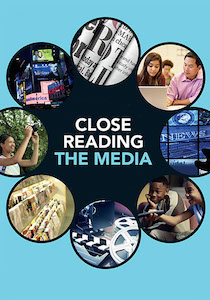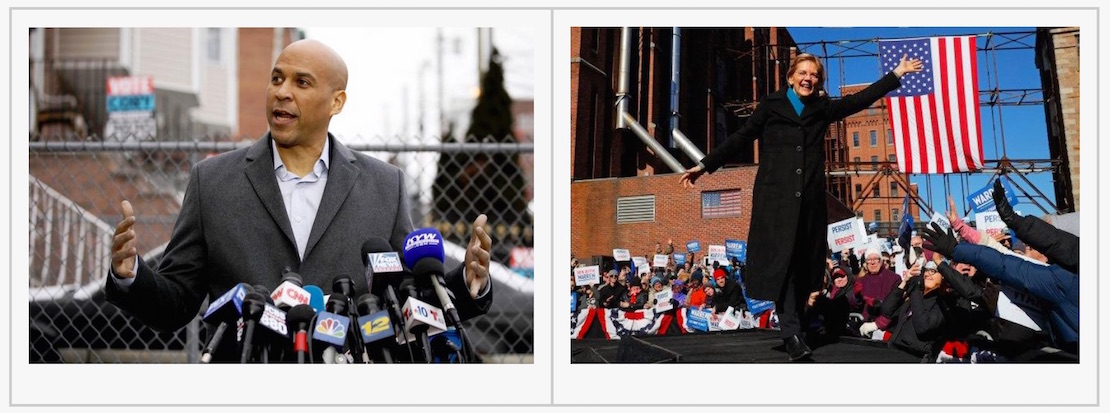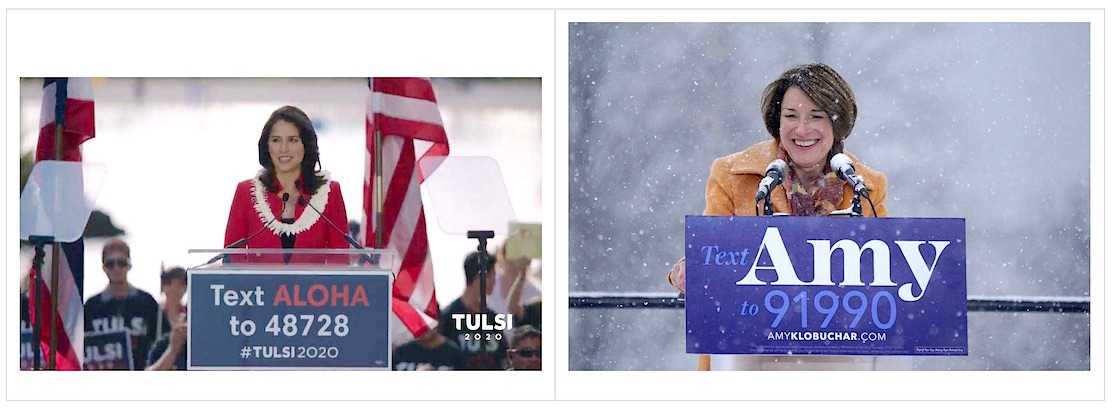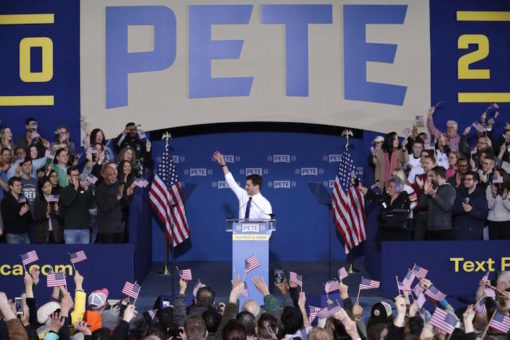Visual & Media Literacy: Political Campaign Optics
A MiddleWeb Blog
T
Real estate has a mantra: “location is everything.” That applies to homes and to businesses. Today, it also applies to politics.
Positioning a home or business just right is critical to future happiness and success. The same can be said of any person running for president – and never more so than in the crowded field of candidates announcing for the 2020 Presidential Election.
Months prior to a candidate announcing his/her candidacy to become President, much time and thought will have been devoted by their campaign to determine the perfect announcement location. What message will it send? And from a social media perspective, what is the announcement’s potential for going viral?
In June 2015 Donald Trump rode an escalator at Trump Tower in New York City and proceeded to a podium to make the announcement. Hillary Clinton conversely used social media, namely YouTube, to make and distribute her announcement.
Stagecraft and Political Optics
Campaign and public relations consultants tell us that visuals are vital and so where a candidate announces speaks loudly to their message. The word stagecraft, common in many drama/theatre settings, has also been used to describe the process of setting up the stage, visuals and sound not only for the audience watching, but perhaps more importantly, for the media which is present to document and deliver it to TV, radio and web audiences. (Among the best late-20th-century users of stagecraft with the media was Michael Deaver, chief aide to President Ronald Reagan, who turned photo-ops into an art form.)
In more recent times, a new word, polioptics, has been used (coined by Josh King, a campaign strategist and Director of Production in President Clinton’s administration) to describe the important role that visuals play in today’s politics. King, author of OFF SCRIPT: An Advance Man’s Guide to White House Stagecraft, Campaign Spectacle and Political Suicide (2016) explains: “The creation, production and distribution of image to persuade audiences in one direction or another is happening all around us.” (Source)
According to Daniel Schill, associate professor in the School of Communication Studies at James Madison University, “Candidates will strategically select locations that articulate the themes of the campaign and reinforce the issues and arguments that will serve as their rationale for running.” (Source)
Increasingly, as educators we need to help students develop and hone their “visual literacy” skills. Visual literacy implies that they can “read” and analyze images. Unfortunately many have not developed these skills. Political optics – and more specifically, the current presidential campaign announcements – offer us a fresh way to become more media literate about politics and the use of visual persuasion.
They’re off and running
If your students have been following the news, perhaps they are aware that many Democrats have already thrown their hats in the ring, announcing in the first quarter of 2019 their intention to seek their party’s nomination for the presidency.
The announcement is the beginning of “the race” – to borrow a word from the sports world. And it is a race because many months must pass between now (Winter 2019) and the Democratic Party’s Convention in July 2020.
As students do some research about “political optics” they’ll discover lots of interesting facts about the marketing of political candidates at the highest levels. Do your students know, for example, that during the candidacy “reveal” special sections are often roped off and set aside specifically for the media? Campaign consultants will often require photographers and other photojournalists to remain in that area so they are positioned to get just the right angle of their candidate – their “best side.”
Consider the images of candidates below that I have culled from various news sources. Ask your students initially: what do you see? Without a caption to inform them, they may have some trouble. But my past experience tells me that when students are given opportunities to conduct a “close read” of an image (even without the caption) they can infer much about intent, simply from what they do see. [The excellent video Explain The Image might be used prior to starting these visual literacy exercises.]
Compare & Contrast
Ask students to compare and contrast each of the photos in this post. What is the same; what is different? Did your students notice, for example, that all of the images are HORIZONTAL. Do they know why? Ask them to think about the photos they take with their mobile phone. Are they mostly horizontal or vertical?
Candidate Photos & Locations
(Click each image pair to enlarge)
Senator Cory Booker (below left), used an unusual setting for his announcement. As HuffPost reported: “Notwithstanding the below-freezing temperatures, Booker’s decision to address reporters outside his Newark [New Jersey] home in a working-class neighborhood provided an opportunity to showcase his status as a hometown favorite. (Booker served as mayor of Newark from 2006 to 2013, before being elected to the U.S. Senate in 2014.)” In the photo, a large number of media microphones are visible and the Senator appears relaxed, without a tie, and is looking at something or someone off camera.
Senator Elizabeth Warren (above right) “chose Lawrence (Massachusetts), an old mill town about 30 miles outside Boston, with a more obscure, but very telling history: Just over 100 years ago in the factory buildings that serve as a backdrop for Warren’s speech, women textile workers defied bosses and bayonets to start a strike, that as Warren said, ‘changed America.’” (Source) In her photo, she is seen waving to supporters while the American flag is strategically visible in the background. [Note: students need to be aware that props, like the American flag, are deliberately placed to make sure they will get in a photojournalist’s frame.]
Senator Kamala Harris (below left) used the holiday of Martin Luther King Jr’s birthday to make her announcement in her hometown of Oakland (California). In this wide shot photo, she speaks from a podium while a large group of supporters is situated behind her, many holding campaign signs. She also appeared on ABC’s “Good Morning America”—which is seen by millions of TV viewers.
Senator Kirsten Gillibrand (above right) kicked off her campaign by criticizing the President with a rally in front of a Trump hotel in New York City. In the photo, the American flag is used as the primary background, but the hotel can also be seen. Previously she had appeared on late night TV (Stephen Colbert) and released an announcement video on social media.
Representative Tulsi Gabbard of Hawaii (below left) made a short announcement on CNN and later appeared at a rally in Honolulu. Teleprompters and flags are prominent in the picture while the candidate is at a podium. Young people appear to be in the background sporting T-shirts in support of the candidate.
Senator Amy Klobuchar of Minnesota (below right), made her announcement during a snow storm. For her outdoor rally she chose Boom Island Park, near the site of the 2007 Interstate 35W bridge collapse” which she was instrumental in fighting for dollars to rebuild. (Source)
Julian Castro (below left) formally announced in his hometown of San Antonio (Texas), hoping to become the nation’s first Hispanic president. In this image, he stands at a podium, with a select group of supporters standing behind him, many holding campaign signs. Former Maryland Congressman John Delaney (below right) made his announcement via an op-ed in the Washington Post newspaper.
Senator Bernie Sanders made his announcement in an email to supporters and during an interview on Vermont Public Radio. Then he held campaign rallies (below right), not in his home state of Vermont, but rather in Brooklyn, NY–where he grew up and attended his first year of college. “Sanders contrasted his spare upbringing with Republican President Donald Trump’s privileged youth as the son of a New York real estate developer.” (Source)
Washington State Governor Jay Inslee (above left) threw his hat into the ring by releasing an ad focused on climate change, which included menacing music, and a stand-up with darkening clouds in the background.
Former Colorado Governor John Hickenlooper (above left) released an ad on YouTube to make his announcement official. The ad highlighted his accomplishments as a Colorado businessman turned politician while at the same time criticizing President Trump. Former Texas Congressman Beto O’Rourke (above right) also released a video, showing him seated alongside his wife in a living room setting. That setting is meant to convey comfort and relaxation – a feeling of “we’re just regular folks.”
Ohio Congressman Tim Ryan (above left) also used television– using an appearance on ABC’s “The View” to make his announcement. California Congressman Eric Swalwell (above right) made it official on CBS’s “The Late Show With Stephen Colbert.”
South Bend Indiana Mayor Pete Buttigieg (above) kicked off his formal campaign with a rally in his hometown. Notice the backdrop directly behind him. Because many people have trouble pronouncing his last name, he has used his first name in large letters as part of the backdrop.
Other announced candidates include: entrepreneur Andrew Yang, author/activist Marianne Williamson, and Miramar (Florida) Mayor Wayne Massam.
Reading the images: Advice & guidance for students
Obviously your students could go online and not only locate other announcement images but also read the transcripts of what each candidate said in their announcement speeches. At the same time, students can locate news stories about the candidates’ announcements and compare and discuss what various news media outlets found newsworthy from the speeches.
If you print out each image as a handout or project an image for all students to see, you can help them begin to identify such things as symbolism, colors, clothes, the use of social media in signage, diversity of audience and much more.
The following questions might also be used to guide student thinking and understanding:
- What is the setting? Why do you think that location was chosen?
- What is prominent in the image? What is missing?
- Where is the camera positioned that took this image? Why do you think it has been placed there? What is shown and what is not?
- What color or colors, and symbols are visible?
- Is the candidate’s name, slogan or other message visible? If so, what is it?
- Why are people pictured behind the candidate holding signs? Where did they get those signs? What do the people look like (represent)? How diverse are they?
- In video announcements: note where the candidate is seen. Who is he/she with? Why do you think they chose those people to interact with? What possible message might that send about the candidate?
If you have time, your students could go to the website for a specific candidate (or YouTube.com) and both watch/listen to the campaign speech. Students could be tasked with taking notes on what they thought was the most salient thing to come from the speech. They could then compare their notes with what the news media reported. Was it the same or was it different and how?
On each of the candidates’ websites, students can also be assigned to read any one of the many position statements. Topics like climate change, education, the economy, foreign affairs and more are likely to be found. Students can listen for how each of those positions is emphasized (if at all) in their campaign announcement speeches.
Take the time to close-read politics
As the race for the presidency heats up, the use of stagecraft and poli-optics will continue to be an important part of everything we see and hear. When we take the time to ask our students to conduct “close readings” of political campaign images and events, we are helping to pull back the curtain on the techniques used by professional image manipulators. In essence, this “visual literacy” activity is an important part of not only their digital citizenship skills, but also their media literacy skills too.
GENERAL RESOURCES:
►This interactive page at the New York Times
will keep you up to date on the field of candidates.
►And follow Frank Baker’s updates on announcements
at his website Media Literacy Clearinghouse.
Recommended Readings
Visual Literacy (chapter from the first edition of my book “Media Literacy in the K-12 Classroom”)
https://www.iste.org/docs/excerpts/MEDLIT-excerpt.pdf
Common Core in Action: 10 Visual Literacy Strategies
https://www.edutopia.org/blog/ccia-10-visual-literacy-strategies-todd-finley
The Art of the Presidential Announcement from Lincoln to Obama
https://abcnews.go.com/Politics/art-presidential-announcement-lincoln-obama/story?id=28699010
Photo-ops: From Reagan to Paul Ryan
https://www.washingtonpost.com/blogs/reliable-source/post/political-photo-ops-from-reagan-to-paul-ryan-the-game-every-candidate-plays/2012/10/17/abc87aae-18ac-11e2-9855-71f2b202721b_blog.html
The High Art—and Power—Of Political Stagecraft in the Age of Optics
https://www.pbs.org/newshour/show/the-high-art-and-power-of-political-stagecraft-in-the-age-of-optics
BOOK: “Off Script: An Advance Man’s Guide to White House Stagecraft, Campaign Spectacle, and Political Suicide.” https://us.macmillan.com/books/9781137280060
BOOK: “Political Campaigns & Political Advertising: A Media Literacy Guide” (excerpt)
The Art of Political Stagecraft – TIME magazine examines an array of stages at conventions from 1868 to present, where evolutions in technology, fashion and architecture have all played a role in how a candidate is portrayed.
http://swampland.time.com/2012/08/29/the-art-of-political-stagecraft/
How Candidates Announce Can Say a Lot About Their Campaigns
https://www.npr.org/sections/itsallpolitics/2015/04/14/399595210/how-a-candidate-announces-can-say-a-lot-about-their-campaign
Visual Literacy: ideas for 21st Century Schools
http://www.21stcenturyschools.com/visual-literacy.html
The 2020 Democratic Presidential Candidate’s Logos Explained
https://www.vox.com/the-goods/2019/3/29/18284489/2020-presidental-candidate-logos-democrats









































